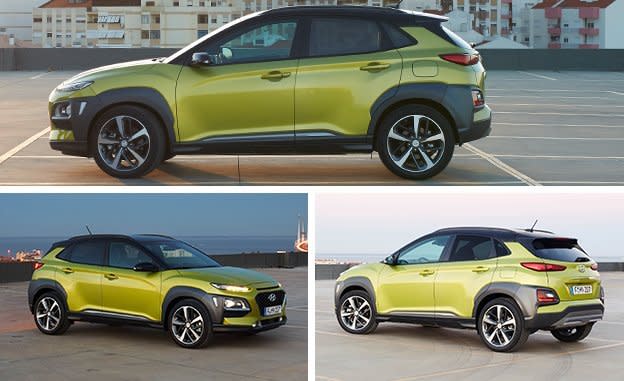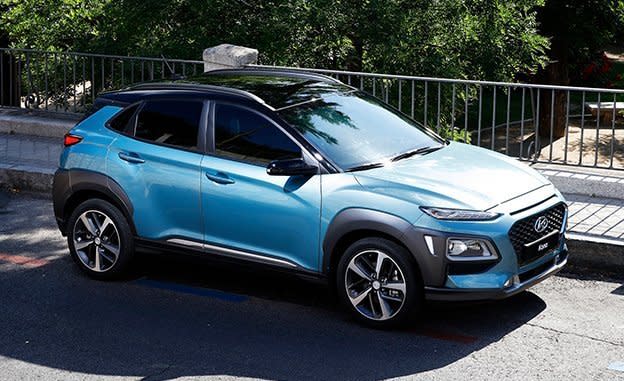2018 Hyundai Kona: The Bean Counters Will Love This Brew

Heretofore Hyundai has been absent from the blossoming mini-ute segment, so the all-new 2018 Kona crossover is a much-needed addition to the lineup. The brand’s push to revamp and expand its entire range of utility vehicles by 2020 will see the B-segment Kona square off against the likes of the Mazda CX-3, the Jeep Renegade, and the 10Best-winnning Kia Soul, among others.
This first Hyundai built upon a new platform expected to underpin a number of future models—not to mention the upcoming Kia Stonic crossover—the Kona is a funky-looking ute geared toward the customers with active and urban lifestyles that so many brands target with their marketing. Its expressive design is highlighted by chunky body cladding around the wheel wells that spills into the front and rear bumpers and breaks up the lighting elements into separate modules.

The stacked, Jeep Cherokee–like LED running lights and headlamps, along with various other body addenda and the semi-floating roof (available in body color or in all black), lend it an odd and somewhat fussy appearance at first glance, especially in photos. But it looks distinctive and more cohesive in person. Expect a similar lighting arrangement and the cascading grille treatment to grace the faces of other upcoming Hyundai SUVs, even though the company says its future designs will emphasize individualistic styling as opposed to a homogeneous look across its lineup.
Proven Hardware
The new chassis, more than half of which is made from Hyundai’s own high-strength steel, employs a strut-type suspension in front while the rear suspension depends on configuration: A solid, torsion-beam axle serves front-wheel-drive models while a multilink arrangement does the duty in all-wheel drivers. The standard U.S.-spec Kona powerplant will be an Atkinson-cycle 2.0-liter inline-four making 147 horsepower and 132 lb-ft of torque, mated to a conventional six-speed automatic transmission. The optional powertrain will be Hyundai’s turbocharged 1.6-liter inline-four producing a stout 175 horses and 195 lb-ft and paired with a seven-speed dual-clutch automatic. Other global markets will see choices Americans won’t be offered, including a turbocharged 1.0-liter three-cylinder and a 1.6-liter turbo-diesel four.
All-wheel drive will be an option with either engine, which are essentially the same as the ones we get in the recently updated Hyundai Tucson. But at 164.0 inches in length, the Kona is about a foot shorter than that vehicle, so it should be notably lighter and wieldier. Standard wheel diameters start at 16 inches, with both 17s and 18s available on higher trim levels. Citing its clipped overhangs and adjustable driving modes (Normal, Sport, and Eco) that alter throttle and transmission programming and vary the torque distribution in AWD models, Hyundai says the Kona has a planted, responsive character in tight city driving.

An overall width of 70.9 inches and a height of 61.0 inches make the Kona comparable with most other mini SUVs. Its 102.4-inch wheelbase, however, is just 2.7 inches shorter than the Tucson’s, which allows a rather spacious cabin. Hyundai took care to package the rear suspension, exhaust, and other components so as not to intrude on the interior, resulting in a relatively airy cocoon and a decent 18 cubic feet of cargo volume behind the rear seat. It may not be the capacious box that is the Kia Soul, but the Kona shames the Mazda CX-3 in usable space.
High-Tech Trappings
The styling inside is less polarizing than the exterior yet still quite attractive. Build quality feels substantial, the ergonomics and control layout are smartly done, and attractive design details, such as body-colored accents around the shifter and vents, add a touch of spice to fancier versions. The leather-trimmed examples we saw also sported contrast stitching and piping on the seats, as well as color-matched seatbelts. Lesser variants sported cloth upholstery with attractive black-and-white houndstooth seat inserts. While our time examining the Kona was brief, overall comfort felt in line with other small, entry-class SUVs.
The cabin also forges new design ground for Hyundai in terms of telematics, with a tabletlike center touchscreen mounted atop the dash. A 7.0-inch unit flanked by redundant hard buttons is standard, and an 8.0-inch setup with navigation is optional. Also spanning 8.0 inches is a retractable head-up display screen that drivers of recent Mazda vehicles will find familiar. Along with full-color graphics and a basic digital speedometer, the optional display also can relay audio, navigation, and active-safety information. Other available tech features include Android Auto and Apple CarPlay compatibility, a wireless charging pad for devices, and 4G Wi-Fi connectivity, as well as a suite of active-safety aids: blind-spot monitoring, rear cross-traffic alert, lane-departure warning and lane-keeping assist, automatic high-beams, a driver-attention monitor, and forward-collision warning with automated emergency braking.

Sales of the Korea-built Kona will commence in its home market later this month, with Europe receiving its first deliveries later this year and America in early 2018. While Hyundai still has to hash out some final specs and exact pricing details for U.S. models, the company says that the Kona will come in SE, SEL, Limited, and Ultimate trim levels and should offer a better value than many of its competitors, which generally start in the $19,000 ballpark and range into the upper $20,000s. Hyundai also says that it is working on a fully electric version with a targeted range of at least 242 miles. The company says that version should appear for the 2019 model year but stops short of confirming it for U.S. sale. The chances of that happening seem good, however, as do those that the standard model will grab a fair share of one of autodom’s most hotly contested segments.

